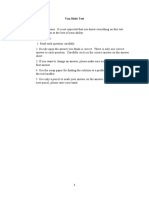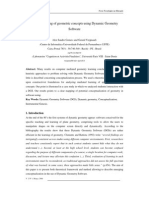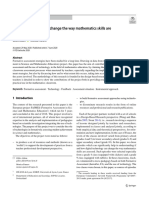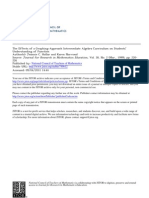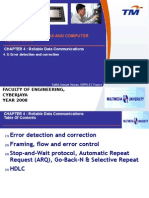Influence of Geogebra On Problem Solving Strategies: Núria Iranzo and Josep Maria Fortuny
Uploaded by
Dhatchana SubramaniamInfluence of Geogebra On Problem Solving Strategies: Núria Iranzo and Josep Maria Fortuny
Uploaded by
Dhatchana SubramaniamNÚRIA IRANZO AND JOSEP MARIA FORTUNY
6. INFLUENCE OF GEOGEBRA ON PROBLEM
SOLVING STRATEGIES
This chapter reports on our research findings about the influence of GeoGebra use
on twelve secondary students’ problem solving strategies in plane geometry. Using
multiple data sources, we analyse the complex interactions among GeoGebra use,
students’ prior knowledge and learning preferences, and the teacher’s role, under
the theoretical perspective of instrumental genesis. We identify three levels of
instrumentalization and instrumentation and provide specific cases to illustrate
students’ use of GeoGebra and their evolving mathematical conceptions in relation
to GeoGebra tools. In general, the use of GeoGebra helps student enhance their
mathematical understanding by enabling alternative problem resolution paths,
and, in some case, help diagnose their learning difficulties. We further discuss
implications for future GeoGebra use and classroom-based research.
INTRODUCTION
This study is related to research about the integration of computational technologies in
mathematics teaching, in particular, the use of dynamic geometry software in the
context of students’ understanding of analytic geometry through problem solving. In
this research we focus on the interpretation of students’ behaviour when solving plane
analytical geometry problems by analysing the relationships among software use,
paper and pencil work, and geometrical thinking. Many pedagogical environments
have been created such as Cinderella, Geometer’s Sketchpad, Cabri géomètre II, and
GeoGebra. In this study we focus on the use of GeoGebra because it is free dynamic
mathematics software and its focus is not only on geometry, but also on algebra and
calculus. Moreover, this may distinguish Geogebra from other geometry software.
GeoGebra links synthetic geometric constructions (geometric window) to analytic
equations and coordinates (algebraic window). We analyse secondary students’
problem solving strategies in both environments: paper and pencil and GeoGebra. As
stated by Laborde (1992), a task solved by using dynamic geometry software may
require different strategies than those strategies required by the same task solved with
paper and pencil, which affects the feedback provided to the student. In this study, we
consider the following research questions:
– What is the relationship between students’ work in both environments?
– How does the use of GeoGebra interact with the paper-and-pencil skills and
the conceptual understanding of 10th grade students when solving plane
geometry problems?
L. Bu and R. Schoen (eds.), Model-Centered Learning: Pathways to Mathematical Understanding Using
GeoGebra, 91–103.
© 2011 Sense Publishers. All rights reserved.
NÚRIA IRANZO AND JOSEP MARIA FORTUNY
We analyse and compare resolution processes in both environments, taking into
account the interactions (student-student and student-GeoGebra), through the
instrumental approach (Rabardel, 2001). The primary purpose of our research is to
offer didactical knowledge in order to understand the ways in which the use of
dynamic geometry software can help promote argumentation abilities in secondary
school geometry. Specifically, we will:
– Characterize students’ resolution strategies for the proposed problems in both
environments.
– Analyse the instrumentation and instrumentalization processes in order to
characterize different behaviours among the students.
– Explore the influence of using GeoGebra (conceptual understanding,
visualization, resolution strategies) on each type of student.
THEORETICAL FRAMEWORK
We consider different approaches for our theoretical framework. The main
theoretical approaches are the instrumental approach (Rabardel, 2001) and the
cognitive approach (Cobo, 1998). We also specify some terms in what follows.
According to Kieran and Drijvers (2006), the perspective of instrumentation is a
theoretical framework that is fruitful for understanding the difficulties of effective
use of technology, GeoGebra in this case. The instrumental approach for using
tools has been applied to the study of Computer Algebra System (CAS) in the
learning of mathematics and also to dynamic geometry systems. In our research,
we apply this framework to the use of GeoGebra, which is a free dynamic
geometry software environment that further provides basic features of CAS. The
instrumental approach distinguishes between an artefact and an instrument.
According to Vérillon and Rabardel (1995), it is important to stress the difference
between the artefact and the instrument: An artefact is a tool, which could be a
physical object, a calculator, or a computer program used by a subject to perform a
task. An instrument is a mental construction built by the subject from the artefact;
so an instrument is a psychological construct.
The process of transforming a tool into a meaningful instrument is called
instrumental genesis. During the instrumental genesis, the student builds up mental
schemes. This process is complex and depends on the characteristics of the artefact,
its constraints, and affordances, and also on the knowledge of the user. This process
of instrumental genesis has two dimensions: instrumentation and instrumentalization.
Instrumentation refers to the process by which the affordances and constraints of
the software influence students’ problem solving strategies and their emergent
conceptions of the problem situations. According to Vérillon and Rabardel (1995),
instrumentation involves forming utilization schemes that provide a predictable and
repeatable means of integrating an artefact and the corresponding actions.
Instrumentation comprises the rules and heuristics for applying an artefact to a
task, through which the task becomes meaningful to the user. We will distinguish,
in the analysis of the students’ resolutions, three levels of instrumentation in
92
You might also like
- Computer Security Principles and Practice 5th Edition PDF33% (3)Computer Security Principles and Practice 5th Edition PDF74 pages
- GeoGebra in The Secondary Mathematics Classroom: A Literature Review67% (3)GeoGebra in The Secondary Mathematics Classroom: A Literature Review19 pages
- Effect of GeoGebra-Aided REACT Strategy On Understanding of Geometry ConceptsNo ratings yetEffect of GeoGebra-Aided REACT Strategy On Understanding of Geometry Concepts12 pages
- Mathematical Attitudes Transformation When Introducing Geogebra in The Secondary ClassroomNo ratings yetMathematical Attitudes Transformation When Introducing Geogebra in The Secondary Classroom26 pages
- Using Graphing Application in Illustrating The Conic Sections: Its Effect On Student's PerformanceNo ratings yetUsing Graphing Application in Illustrating The Conic Sections: Its Effect On Student's Performance7 pages
- Technology in Mathematical Problem SolvingNo ratings yetTechnology in Mathematical Problem Solving28 pages
- Pamungkas 2021 J. Phys. Conf. Ser. 1918 042082No ratings yetPamungkas 2021 J. Phys. Conf. Ser. 1918 0420827 pages
- GeoGebra Software in Teaching and Learning GeometrNo ratings yetGeoGebra Software in Teaching and Learning Geometr24 pages
- Al-Jabar: Jurnal Pendidikan Matematika Vol. 6, No. 2, 2015, Hal 99 - 109No ratings yetAl-Jabar: Jurnal Pendidikan Matematika Vol. 6, No. 2, 2015, Hal 99 - 10911 pages
- The Development of Mathematical Achievement in Analytic Geometry of Grade-12 Students Through Geogebra ActivitiesNo ratings yetThe Development of Mathematical Achievement in Analytic Geometry of Grade-12 Students Through Geogebra Activities11 pages
- Samosir 2020 J. Phys. Conf. Ser. 1480 012022No ratings yetSamosir 2020 J. Phys. Conf. Ser. 1480 0120227 pages
- On Usage of Visualization Tools in Teaching Mathematics at UniversitiesNo ratings yetOn Usage of Visualization Tools in Teaching Mathematics at Universities8 pages
- Jones  ESM  2000 Deductive  ReasoningNo ratings yetJones  ESM  2000 Deductive  Reasoning32 pages
- Mathematical Modelling in The Primary School: Queensland University of TechnologyNo ratings yetMathematical Modelling in The Primary School: Queensland University of Technology8 pages
- Digital Technologies For Learning Mathematics OutlineNo ratings yetDigital Technologies For Learning Mathematics Outline4 pages
- Integral Definida en Diversos Contextos Un Estudio PDFNo ratings yetIntegral Definida en Diversos Contextos Un Estudio PDF26 pages
- Q4 The Development of Geogebra-Assisted Mathematics Learning Media On Geometry of Space Flat-Side of Cubes and Blocks PDFNo ratings yetQ4 The Development of Geogebra-Assisted Mathematics Learning Media On Geometry of Space Flat-Side of Cubes and Blocks PDF6 pages
- Geogebra For Model-Centered Learning in Mathematics EducationNo ratings yetGeogebra For Model-Centered Learning in Mathematics Education6 pages
- Learning Objects and Geometric Representation For Teaching "Definition and Applications of Geometric Vector"No ratings yetLearning Objects and Geometric Representation For Teaching "Definition and Applications of Geometric Vector"18 pages
- Effect of Duval Cognitive Model On Geometric Reasioning: Dr. Manju GeraNo ratings yetEffect of Duval Cognitive Model On Geometric Reasioning: Dr. Manju Gera11 pages
- A Study About Teaching Quadratic Functions Using Mathematical Models and Free SoftwareNo ratings yetA Study About Teaching Quadratic Functions Using Mathematical Models and Free Software8 pages
- Developing A Computer-Based Assessment of Complex Problem Solving in ChemNo ratings yetDeveloping A Computer-Based Assessment of Complex Problem Solving in Chem15 pages
- Using of Geogebra To Improve Mathematical Reasoning With The Problem-Solving MethodNo ratings yetUsing of Geogebra To Improve Mathematical Reasoning With The Problem-Solving Method7 pages
- Can Digital Technology Change The Way Mathematics Skills Are Assessed?No ratings yetCan Digital Technology Change The Way Mathematics Skills Are Assessed?16 pages
- Research Paper GeoGebra-Wesley Van WoudenbergNo ratings yetResearch Paper GeoGebra-Wesley Van Woudenberg45 pages
- The Effects of A Graphing-Approach Intermediate Algebra Curriculum OnNo ratings yetThe Effects of A Graphing-Approach Intermediate Algebra Curriculum On8 pages
- Technology Support For Learning Exponential and Logarithmic Functions (#373503) - 396668No ratings yetTechnology Support For Learning Exponential and Logarithmic Functions (#373503) - 39666819 pages
- System Dynamics Through Qualitative Modeling in DynaLearn: Results From Research Conducted in A Brazilian High School ContextNo ratings yetSystem Dynamics Through Qualitative Modeling in DynaLearn: Results From Research Conducted in A Brazilian High School Context8 pages
- First Steps in Understanding Engineering Students' Growth of Conceptual and Procedural Knowledge in An Interactive Learning ContextNo ratings yetFirst Steps in Understanding Engineering Students' Growth of Conceptual and Procedural Knowledge in An Interactive Learning Context12 pages
- Teaching and Learning Calculus With Free Dynamic Ma-Thematics Software GeogebraNo ratings yetTeaching and Learning Calculus With Free Dynamic Ma-Thematics Software Geogebra9 pages
- Developing Mathematical Competencies in Secondary Students by Introducing Dynamic Geometry Systems in The ClassroomNo ratings yetDeveloping Mathematical Competencies in Secondary Students by Introducing Dynamic Geometry Systems in The Classroom17 pages
- SacristanEtAl - Constructionism2020 October CleanNo ratings yetSacristanEtAl - Constructionism2020 October Clean12 pages
- Teaching and Learning in STEM With Computation, Modeling, and Simulation Practices: A Guide for Practitioners and ResearchersFrom EverandTeaching and Learning in STEM With Computation, Modeling, and Simulation Practices: A Guide for Practitioners and ResearchersNo ratings yet
- Constructing Dynamic Triangles Together: Gerry Stahl's eLibrary, #6From EverandConstructing Dynamic Triangles Together: Gerry Stahl's eLibrary, #6No ratings yet
- The Implementation of Animation (Computer Software) in Teaching Sustainable Architecture (Education for Sustainability) with Specific Reference to the Sun.From EverandThe Implementation of Animation (Computer Software) in Teaching Sustainable Architecture (Education for Sustainability) with Specific Reference to the Sun.No ratings yet
- Problem Solving Ability Measuring Questions (PSAMQ) : DirectionNo ratings yetProblem Solving Ability Measuring Questions (PSAMQ) : Direction3 pages
- Geogebra Assist Discovery Learning Model For Problem Solving Ability and Attitude Toward MathematicsNo ratings yetGeogebra Assist Discovery Learning Model For Problem Solving Ability and Attitude Toward Mathematics7 pages
- ABB Arc Flash Hazard Mitigation-CATALOGO TECNICONo ratings yetABB Arc Flash Hazard Mitigation-CATALOGO TECNICO6 pages
- GSM Bss Network Kpi (Rxquality) Optimization Manual: PDF Created With Pdffactory Trial VersionNo ratings yetGSM Bss Network Kpi (Rxquality) Optimization Manual: PDF Created With Pdffactory Trial Version17 pages
- Artificial Neural Network Based MPPT of Solar Photovoltaic CellsNo ratings yetArtificial Neural Network Based MPPT of Solar Photovoltaic Cells11 pages
- Visvanath Cakravarti Thakura Sri Sankalpa KalpadrumaNo ratings yetVisvanath Cakravarti Thakura Sri Sankalpa Kalpadruma50 pages
- Math 240: Matrix Operations and Linear Systems: Ryan BlairNo ratings yetMath 240: Matrix Operations and Linear Systems: Ryan Blair25 pages
- ST - Thomas Technical High School: School Based Assessment (Sba) Project 2023 - 2023No ratings yetST - Thomas Technical High School: School Based Assessment (Sba) Project 2023 - 20235 pages
- Database Fundamentals: Robert J. Robbins Johns Hopkins UniversityNo ratings yetDatabase Fundamentals: Robert J. Robbins Johns Hopkins University31 pages
- Proposal for Review of Codal Life 13.04.2020100% (1)Proposal for Review of Codal Life 13.04.202024 pages
- Summative Assessment - Introduction To Spreadsheets - Y6No ratings yetSummative Assessment - Introduction To Spreadsheets - Y64 pages
- Irakli Saparishvili @safareli: Foam SpaceNo ratings yetIrakli Saparishvili @safareli: Foam Space1 page
- K To 12 ICT - Computer Systems Servicing (NC II) Curriculum Guide May 2016 LO - Learning Outcome ofNo ratings yetK To 12 ICT - Computer Systems Servicing (NC II) Curriculum Guide May 2016 LO - Learning Outcome of2 pages
- De - Continuous Assessment Card - Format - 659523100% (2)De - Continuous Assessment Card - Format - 6595239 pages
- Conducted by NIELIT Jorhat EC Venue: Nielit Jorhat Ec Isbt 1 Floor, Tarajan, JorhatNo ratings yetConducted by NIELIT Jorhat EC Venue: Nielit Jorhat Ec Isbt 1 Floor, Tarajan, Jorhat26 pages
- April 2024, Training Announcement, IIT DELHI (IOT, LiFi, 5 PHy Layer and 5G Network Security) - (1) (3) - 1No ratings yetApril 2024, Training Announcement, IIT DELHI (IOT, LiFi, 5 PHy Layer and 5G Network Security) - (1) (3) - 11 page
- The Holy Bible in The Original Hebrew Old and Greek New Testamentby Brooke Foss Westcott, Fenton John Anthony Hort 1888No ratings yetThe Holy Bible in The Original Hebrew Old and Greek New Testamentby Brooke Foss Westcott, Fenton John Anthony Hort 18881,215 pages
- EPLAN Platform 2024 - Update - Installation - ENNo ratings yetEPLAN Platform 2024 - Update - Installation - EN8 pages

